
Part 1
NARRATOR - From early on the 26th of December, 1996, when police arrived to investigate a reported kidnapping at the Ramseys' Colorado home, they thought the parents were behaving strangely.

Their suspicion grew that afternoon when John Ramsey discovered his daughter's body in this small cellar.

By the time the body was removed late that evening, the police were almost certain the parents were involved.
They found no evidence of a break-in, and no footprints in the snow. No one could have gotten in - something even the mayor confirmed.
MAYOR LESLIE DURGAN - By our reports, there was no visible sign of forced entry. The body was found in a place where people are saying someone had to know the house.
John and Patsy Ramsey now found themselves isolated and reviled. Few believed them when they said there was a killer on the loose. Instead, they were accused of deliberately sexualizing their daughter, turning her into a pedophile's dream.
Police were said to believe that the parents had at first abused JonBenét, and then murdered her, faking the kidnapping plot to cover it up.
Six weeks after the killing, District Attorney Alex Hunter held a press
conference. 
FEB 13 PRESS CONFERENCE - ALEX HUNTER - "I want to say something to the person or persons that took this baby from us. The list of suspects narrows. Soon there will be no one on the list but you."
NARRATOR - Few doubted he was addressing the Ramseys - now openly branded by many as murderers.

But despite his public confidence, behind the scenes, a split was already developing between police and the DA. Hunter feared the police investigation was getting nowhere. To help, he decided to bring in the best homicide detective he could find.
Colorado Springs. Alex Hunter's search ended here.
After looking at over 80 detectives he chose Lou Smit - who, like his Delorean sports car, had become an American legend.
LOU SMIT IN CAR - "I remember telling my wife I said, 'Honey if you don't want me to do this I won't.' because I was retired, I was taking it easy, but sometimes in life you have challenges and you just have to rise to meet them."

NARRATOR - During his 32 year career, Smit investigated more than 200 murders. He solved over 90 per cent of them. He never lost a case in court. He'd worked for the Colorado Springs Police Department, DA's office and coroner. His last job was running homicide investigations for the El Paso County Sheriff's Office.
Under Smit, the sheriff's office cleared up all its unsolved murders and even solved older cases that had been closed.
LOU SMIT (looking at photo album, talking about arrest in Dawn Church case) - Boy that was something, the day we caught him, we must have had fifty cars all lined up there.... .
NARRATOR - The decision to involve Smit in the Ramsey case was widely approved.
JOHN ANDERSON - That was a brilliant decision. In crime scene investigation, Lou's the very best. He's been there. He's been there in the field. He's seen those. He just didn't read about them, he'd actually been there over and over and over. Lou Smit, is the very best violent crimes homicide detective that I know.
NARRATOR - By the time Smit joined the investigation, the couple were being hounded everywhere they went.
One of their lawyers, worried by Smit's appointment, telephoned Colorado's former chief public defender, Greg Walta, to ask about him.
GREG WALTA - "He knew I'd tried cases against Smit. I told him that if the Ramsey's were guilty, they'd better look out because Smit would nail them and if they were guilty not to let them talk to Smit. He'd get under their skin and he'd get information that would kill them. On the other hand, I told him that if they were innocent, go ahead and cooperate, because this guy has integrity. He'll follow that evidence wherever it goes, and if it leads away from the Ramsey's, he would follow it.
NARRATOR - Smit, driving his family's camper van, arrived in Boulder three months after the killing. His task - to investigate the murder for the DA's office and to pass on his findings to the police leading the investigation. He didn't think it would take long.
LOU SMIT driving van - "It seemed as though the parents were probably involved in it. From what I'd seen in the newspapers and heard on television was that there'd been snow all around the house, there were no footprints in the snow, how could anyone get into the house? The ransom note was supposedly written inside the house. I thought this would be a fairly easy case. I thought it would be a slam dunk.
NARRATOR - At first, the police welcomed Smit's arrival. One detective referred to his "terrific reputation". And indeed, his first discoveries would be dramatic.
End of part one
Part 2
Lou Smit arrived in Boulder, Colorado to begin his investigation into the killing of JonBenét 3 months after her death.
LOU SMIT - Every morning at 7 o'clock I'd always come down to this particular spot. I would just say a little prayer, drink a cup of coffee and ah, just more or less get myself ready to go for the day.
NARRATOR - Even months after the murder, for Smit, the crime scene remained the most important part of his investigation. He was certain the killer would have left clues. It was just a matter of finding them.
LOU SMIT - When you're not on a crime scene, you do miss out on quite a bit of the feelings that you get during the initial investigation. That's where photographs really do come in. Boulder Police Department did take great photographs. I did spend a great deal of time inspecting each and every one of those photographs and they did tell me a story.
NARRATOR - Much of the house had been disturbed by friends who had gone to help the Ramseys. This made one police photograph particularly significant.

LOU SMIT - JonBenét's body was right behind that door when this photograph was taken. If that door would have been opened at that time, this case would have taken an entirely different turn. Everyone in the house would have been cleared out - nothing would have been disturbed.
NARRATOR - Smit found other early photographs that also worried him.

LOU SMIT - This photograph does show a lot of snow around the house
and if you seen this, your first perception would be that a person who
entered that house would have to leave some footprints in the snow.
Now take a look at this photograph - the sidewalks are completely
clear of snow.
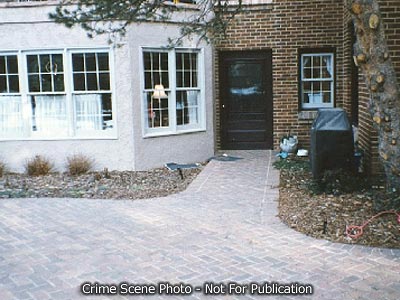
Another rather significant photograph taken from the alley. A person approaching this house from the alley would leave no footprints around the house.
NARRATOR - Smit was surprised at the lack of snow, but the fact that someone could have reached the house did not mean anyone had. But it meant that he had to looking for evidence of an intruder which might have been missed. Because the family had been out visiting friends late on the murder, there was plenty of opportunity for such a break-in.
LOU SMIT - If an intruder had spent any time at all checking out the house he would have noticed that on various doors and windows there was a sticker indicating that the house was alarmed. On a lot of these older houses, the windows leading into the basement are not alarmed and that drew my attention to this window on the north side of the house. It's a small window leading into the basement. When we inspected the photographs we did see something very interesting.

NARRATOR - Smit found the dust on the window frame had been disturbed. He also found what he thought were finger marks. He concluded that someone may have tried to open this window. Yet an interior photograph showed it remained locked and undisturbed - if there was an attempt, it had failed.
However, another photograph, taken in the basement, suggested a second attempt could have succeeded.
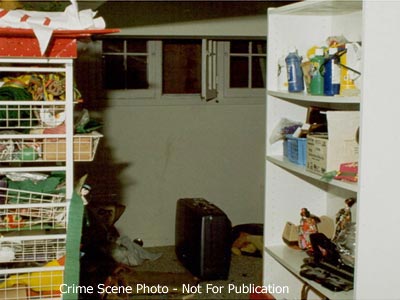
LOU SMIT - Now this is a photograph that really caught my eye because the window was wide open. But what also caught my attention was a mark on the wall leading right directly from the window down the wall going down to the floor. When I first seen that photograph I thought, "Uh oh, looks like somebody could have got in here."
NARRATOR - That open basement window was at the side of the house, underneath an unlocked metal grill. According to Smit, if an intruder had got in this way, there would be evidence here on the outside, as well as on the inside.
LOU SMIT - And that's exactly what the photographs show me. There was a great deal of foliage which was on the front of the grate and it had actually been pinched under the leading edge of that grate. Even when you pick the grate up, you can see very clearly that there was green foliage right on the plate the grate rested on.
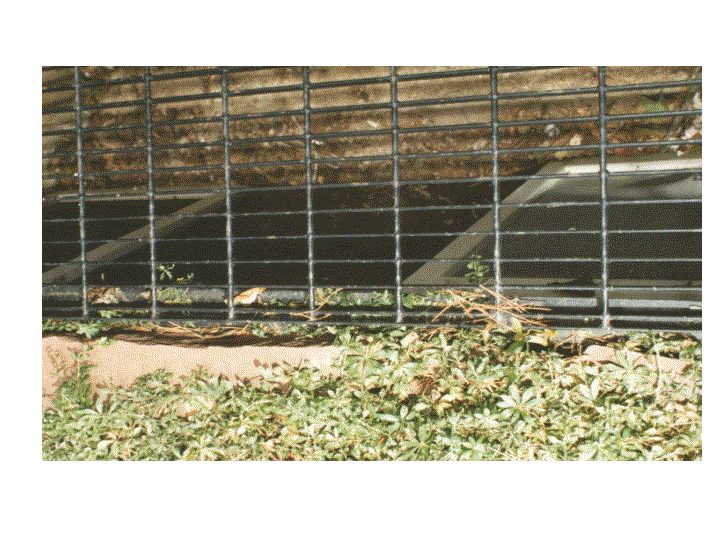
Also, in looking into the window well, the window in the center, that
had been opened, had a great deal of disturbance in that particular area
of the window. You can also see was appears to be finger marks on
the window frame itself.

NARRATOR - All this convinced Smit an intruder could easily have got in this way.
Lou SMIT - You know its been said that only a midget can get down into that window well, well I'm no midget and I'll show you how easy that can be done.
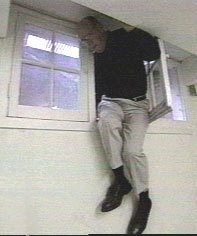
NARRATOR - Smit knew that the local police had said they'd found no evidence of an intruder. Although his evidence so far was inconclusive, he felt it should, at least, be kept in mind.
The Boulder police rejected his advice. Lead detective Steve Thomas, later publicly described the idea of an intruder as "far fetched" and "ridiculous".

Ignoring Smit's advice, police set out to intensify media pressure on the Ramseys. Lacking evidence to justify their arrest, they hoped this might break the couple, forcing a confession.
The fact that Patsy Ramsey, a former beauty queen, had entered JonBenét in children's pageants, fueled accusations of sexual abuse. Now it was leaked that police had warrants to search the Ramsey home for pornography. It led to a media frenzy.
JOHN RAMSEY 5/1/97 Press conference - "I did not kill my daughter JonBenét. There have also been innuendoes that she has been or was sexually molested, I can tell you that those were the most hurtful innuendoes.... "
NARRATOR - No link with pornography or sex abuse was ever found. But when the Ramseys talked to journalists in an attempt to plead their innocence, no one believed them. Yet by the time of that press conference, Smit had found more compelling evidence of an intruder.
End Part 2
Part 3
NARRATOR: Early in Detective Lou Smit's investigation, he had found evidence of a break-in through a window at the Ramsey home. Now more evidence started to emerge.
LOU SMIT - The open window itself really wouldn't mean too much. But if an intruder came in here he would have left other clues behind him. This is the way he would have come. And it's only a short distance to the staircase that leads upstairs. And up these stairs we found one of the most important clues in this case.
In this small alcove just off the kitchen was the pen that was used to write the ransom note. Just a short distance away, on a small table, was the pad that the ransom note was written on.


Could the killer have written the ransom note here? Sure!
Do we know for sure? No!
But the ransom note, we do know, is one of the best clues left
behind by this killer.
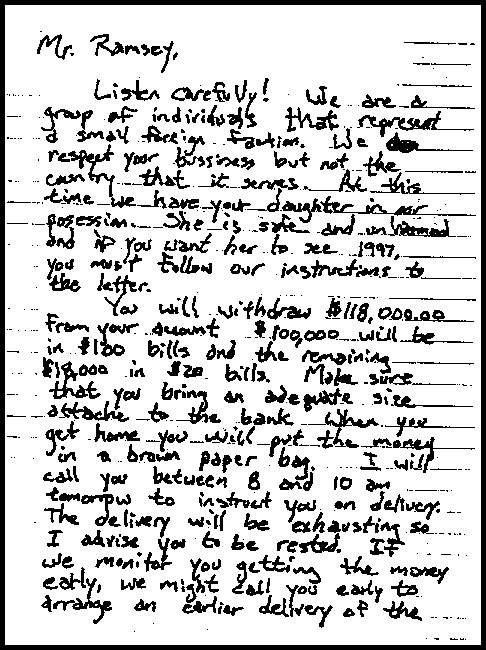


LOU SMIT AT COMPUTER - First of all, it was done in a very calm and controlled way. The person was not writing in panic. I have interviewed many many murderers - and even psychopaths, after a murder they're extremely agitated. It is very difficult for them even to sit down. In my estimation there is just absolutely no way that they could have written that note after that murder. I believe that this note was written before the murder.
This note suggests violence, what he's going to do to this little girl.
"If you want her to see 1997..."
"... will result in the immediate execution of your daughter..."
" you will be denied her remains for proper burial..."
"will result in your daughter being beheaded..."
"she dies",
"she dies",
"she dies",
"she dies",
"99% chance of killing your daughter."
"don't think that killing will be difficult..."
This is what the killer is saying. Its vicious and brutal.
It's the personality of our killer.
NARRATOR - Smit was dubious about the police view that Patsy Ramsey wrote the note.
LOU SMIT - I know that is the common opinion in the case, however six competent examiners did examine that note and she rated very low on the scale and I can tell you this, there's no way that Patsy Ramsey could have written that note afterwards. If she wrote it before, fine, that way she could think in a very clear and logical way. No way Patsy could have wrote that afterwards, after murdering her daughter. That's for sure.
LOU SMIT back in house - Whether or not the note was written in this
alcove or not, we don't know, but we do know that the ransom note was found
on the bottom step of this spiral staircase. From here
it's only a short distance to JonBenét's room.
This is JonBenét's bedroom but the room right next to it is
the guest bedroom and there was a real interesting thing that we found
out about this room. This window overlooks the garage
and the driveway and would be a great vantage point for anyone that would
want to see if the Ramseys were coming home that night.
What's interesting about this room - we did see that some of the drawers
in the bathroom, right off the bedroom, were partially open - looked like
they were out of place.
Also in this room there was found a rope and we don't know where that
rope came from. No one can explain why that rope is in this room.
Also what was real interesting in this room, and it's just a small
detail, is that there was a dust ruffle that was tucked in except for just
a small area that seems to have been pulled out. Now does that mean
that the killer may have been under that bed? We just don't know.
But it's just an observation. One of the small things that detectives
look for. He could have been under there and it would be a perfect
vantage point for him to go right into JonBenét's bedroom in order
to take her out later.
RAMSEY HOME VIDEO - Christmas - JB is hugging "Sister Socks", the stuffed cat she was later buried with. PR draws her attention to a large bride doll."
NARRATOR - While Smit was finding troubling evidence pointing toward an intruder - the police were now developing a new theory. They believed that JonBenét had been killed by her mother, Patsy, who had lashed out in anger after her daughter had wet her bed.
The police were angered at Smit's increasing suspicion that they were wrong - and angered, too, that prosecutors in the District Attorney's office, were beginning to listen to him.
Lead detective Steve Thomas accused Smit and DA staff of 'losing touch with reality' and of 'impeding the investigation'.
Concerned at the hostility, Smit turned to his old boss, John Anderson, the Sheriff of El Paso County, for advice. Anderson, who runs one of Colorado's most respected police departments, is an expert on crime scene analysis.
JOHN ANDERSON - I did look at some of the photos and was very intrigued. Lou clearly had physical evidence that I think he justifiably should have been concerned that people were ignoring and there seemed to be a tendency that if the lead didn't connect one of the family members, and ultimately one of the parents, the lead should be dismissed, that it was of no value. And that was very concerning. I thought there was a lot of physical evidence that pointed to someone other than a family member.
NARRATOR - Despite this, police still hoped to force a confession and media pressure on the Ramseys intensified.
DATELINE TAPE -
reporter: Vanity Fair says Boulder police are so sure of their case,
they've had arrest affidavits prepared since May.
Ann Bardach:- They list evidence against the two parties
reporter:- John and Patsy Ramsey?
Ann Bardach:- In quite specific detail.
reporter:- And this information supports a charge of what?
Ann Bardach:- murder.
NARRATOR - But by then, Smit had uncovered dramatic new evidence which would change everything.
end part 3
Narrator - Two months after his appointment by the DA's office, special investigator Lou Smit was about to make a discovery which would change everything.
LOU SMIT - We don't know if the killer was in there or not, but it's
only a few quiet steps into JonBenét's room.
This is where JonBenét's bed was. She was asleep
in bed. The photographs show that the sheets on her bed were
clean. There was no sign of urine on those sheets. There is
no evidence that JonBenét wet her bed that night. There was
no sign of a struggle in this room.


NARRATOR - The bed was not disturbed. Nor was the bed side table. The absence of a struggle pointed towards the parents.
LOU SMIT -Someone that JonBenét knew, like her parents, could have taken her from the bed without a struggle taking place.
NARRATOR - Smit discovered how she was taken while pursuing another problem - the cause of marks on her back and face which the autopsy report described as "unexplained abrasions".
LOU SMIT - We were pretty sure that these injuries were not on JonBenét beforehand because pictures were taken of her earlier that day. So these injuries occurred right at or about the time of death so we had to find out what these marks were.
NARRATOR - The explanation came when he and a lawyer in the DA's office,
by chance, put these two photographs together.
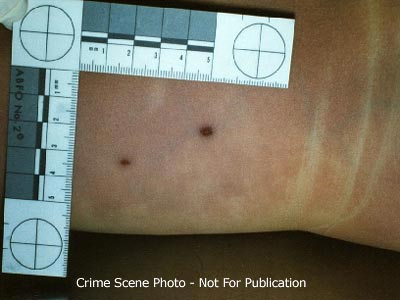 on back
on back 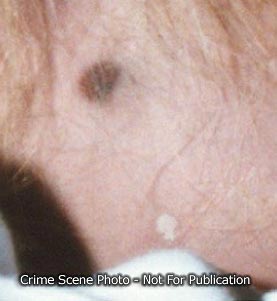 on face
on face
LOU SMIT - Suddenly it became apparent that the marks themselves, both on the back and on the face, were the same distance apart. Suddenly a little light went on and it was just like, wait a minute, and we both hit on it at the same time, that it was a stun gun.
NARRATOR - Smit looked for other murder cases where a stun gun had been used and found Gerald Boggs. These photos show the injuries made by the weapon in the Boggs case.

LOU SMIT - They compared very closely with the same marks on JonBenét. In fact the marks were on the same side of the face and it was a large mark and a small mark. The reason that happens that way is because if contact of the stun gun is placed directly against the skin, it leaves a smaller mark But if the other contact is left off the skin just a little bit, the arc of electricity dances around on the skin causing the larger mark.
NARRATOR - Smit also identified the particular weapon which he believed caused these injuries.

LOU - The stun gun that we came up with is this one and its the Air Taser stun gun. If a stun gun is used on a little girl I'm sure it would have knocked her flat and it would have allowed the killer to take her from her bed without her struggling
NARRATOR - The Boulder police rejected Smit's evidence about a stun gun. They spoke to Colorado's leading expert, pathologist Mike Dobersen, and claimed he discounted the possibility.
MIKE DOBERSEN - That's right - and that was something of a mistatement since my real conclusion was that I couldn't, at that time, say whether this was a stun gun injury or not because we had to have a weapon to compare it to.
NARRATOR - When Smit showed him the Air Tazer stun gun, Doberson took a different position.
MIKE DOBERSEN - Lou had found a weapon with characteristics which fit as exactly as you could expect, the injuries on JonBenét's body.
NARRATOR - Since then, Mike Dobersen has conducted experiments on anaesthetized
pigs. The Tazer stun gun exactly replicated the injuries
on JonBenét and the distance, 3.5 centimeters, between those
injuries.
.

MIKE DOBERSEN - My experiments, and the observations that we made and all the work that's been done, I feel that I can testify to a reasonably degree of medical certainty that these are stun gun injuries.
LOU - If a stun gun is used, it is an incredible clue left behind by the killer. It's not often that he leaves a good clue like this, but just to disregard it, would be incredibly foolish. Because if a stun gun is used on JonBenét, it points directly at an intruder. It does not point at a parent.
NARRATOR - What happened next to JonBenét is clear.
LOU SMIT - We're fairly certain that JonBenét was taken from her room down this spiral staircase. There was garland on the railing of the spiral staircase and there was also garland found in the hair and on the clothing of JonBenét. We know that the killer brought JonBenét down into this basement, there's no doubt about that, and we found some very significant evidence in this room.
NARRATOR: Smit says in the room in the basement where there was evidence of a break-in, something else significant was found.
LOU SMIT - There were items in that suitcase which contained fibers which were found on the outside of the clothing of JonBenét. Is it possible that her killer tried to put JonBenét in that suitcase? Is it possible that he tried to take her out this window in this suitcase? Could it have been a kidnapping followed by a murder? Very easily it could have been. Perhaps he had intended to take JonBenét out that window and he just couldn't get her out, and he decided to kill her.
NARRATOR - When Smit presented his evidence to the Boulder police, they
rejected it. Lead detective Steve Thomas said the intruder was 'non-existent'
and the idea of a stun gun 'preposterous'. While Smit's findings
were kept confidential, the police leaked their theory to the media.
According to Smit, what actually happened was very different.
JonBenét was garrotted to death.
SMIT - There's very strong evidence that JonBenet was killed in this part of the basement and one of the reasons for that is that there was a paint tray right there, and in this paint tray was a paintbrush that was used to make the garrotte.


The bristle portion was still in the tray. Right next to the paint tray is a very small sliver of wood that came off of that broken brush.
The garrotte was made of the middle portion of that paintbrush, the handle.
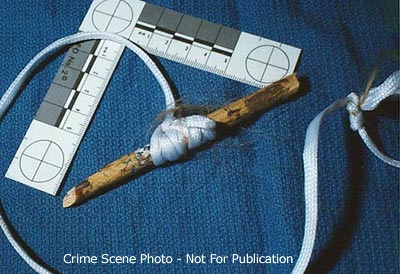
Her hair was actually entwined right in the wrappings of the garrotte as the killer made it on the back of her neck, most likely when she was lying face down on the floor.
He made a noose on the other end of this garrotte. Then this noose was pulled very tightly against the neck of JonBenét, almost like a control device.
NARRATOR - With a growing conviction that the killer was a violent sexual offender who had broken in to the Ramseys home, Smit again returned to Colorado Springs to seek advice. This time from Bob Russell, the City's former district attorney.
BOB RUSSELL - We spent five or six hours going through some of the evidence and the pictures he has and at that time I became convinced that the Ramseys didn't do this.
NARRATOR - Russel's view is widely respected. He's an expert on violent crimes against children. He was spokesman for the US National District Attorney's Association on the subject.
BOB RUSSEL - Garrotting requires a deliberation, you have to think about it, you have to throw the rope around the neck. In this particular case you had to create an exact kind of knot, he had to twist the knot, all while that child is still alive. Most of the time that's a sexual kind of killing.
NARRATOR - Russel also believesthat the evidence of a violent sexual assault on JonBenét points to someone other than her parents.
BOB RUSSEL - Parents don't kill in that manner. They bash, they throw the child down, they hit them on the head and they do things of that nature. And what makes me believe this is also probably a sexual kind of killing is that there, there is an object that's jammed through the vagina of the child because blood is drawn. And that's not something a parent does, let alone a mother.
NARRATOR - Ignoring Smit's findings, Boulder police took prosecutors to the Ramsey home as part of a presentation of the case against the parents - that they had killed their daughter and then staged the garrotting and kidnapping to cover it up. But prosecutors did not find this convincing as District Attorney Alex Hunter made clear.
DA ALEX HUNTER - We don't have enough to file a case. We have more work to do. This is a tough case, you all know that..
NARRATOR - In fact, the DA's office believed local police had gotten nowhere and now prepared to take over the entire investigation themselves. They had no idea of the extraordinary development that would soon overwhelm them.
End Part 4
Part 5
NARRATOR - Eighteen months after the murder of JonBenét in her home on Christmas night, the Boulder DA's office took over the entire investigation from local police whom they thought had failed. John and Patsy Ramsey immediately returned to Boulder. They believed the DA's office, unlike the police,would treat them fairly. They submitted themselves to separate and open-ended videotaped interrogations by DA investigators, including Lou Smit.
John Ramsey (in interview with Lou Smit) - Our view is that the cruelty that was willfully imposed on us and our family by the Boulder Police was only exceeded by what the killer did to us. That's our perspective and so.... that's behind us, let's move forward and...
NARRATOR - By now, at the DA's office, there was a growing belief in the Ramseys' innocence. One reason was they now believed they knew how JonBenét had been killed.
LOU SMIT - This is not a simple little blow to the head followed by massive staging. This is brutal first degree murder
NARRATOR - The killer first placed the garrotte low on JonBenét's neck - throttling but not killing her. As the garrotte was pulled tighter, it rode higher up her neck.
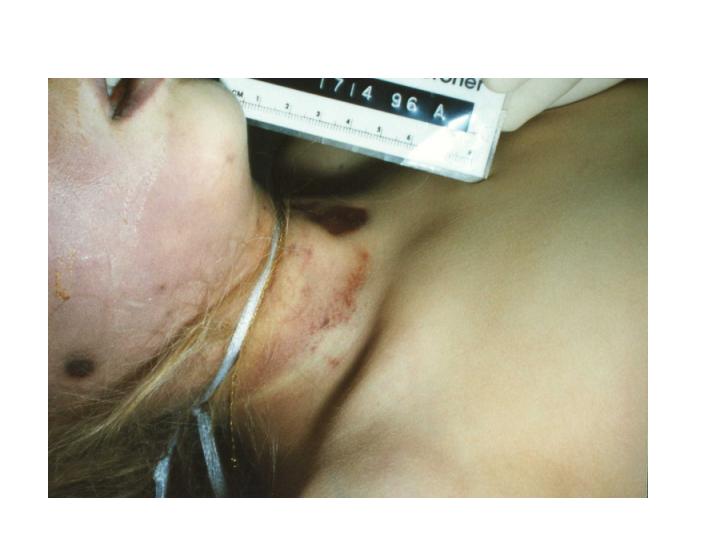

LOU SMIT - When you look at the injuries on the front of JonBenét's neck, you can see the amount of force that was exerted on that garrotte and that man pulling that handle, because it abraded the skin all the way up into the furrow of that garrotte..
But the most significant part of this particular photograph is that there's half moon abrasions direction above the ligature. These most likely are fingernail marks where JonBenét was trying to get the garrotte from her neck. She tried to save her own life. She tried everything she could to scream and to get away from that. And whoever did that to JonBenét had to see her doing this and feel her doing this to try to get that garrotte off of her neck. This is a very brutal killing. Nothing in the family background would indicate to me that they're this brutal a people at all, not even for one night.
JOHN RAMSEY (in interview with Lou Smit) - I would have given my life for JonBenét in an instant and I regret that I was unable to. Patsy feels the same way.
NARRATOR - After just three days of intensive interrogation, Lou Smit and the DA investigators challenged the ramseys by telling them there was evidence linking them to the murder
INTERROGATOR HANEY - I'm talking about scientific evidence
PATSY RAMSEY - I don't give a flying flip how scientific it is - go back to the damn drawing board! I didn't do it! John Ramsey didn't do it and we didn't have a clue of anybody who did. So we all got to start working together from this day forward to try to figure out who the Hell DID it! I mean I appreciate being here. I appreciate it. It's very hard to be here but it is a damn sight harder being at home in Atlanta, Georgia wondering every second of every day what you guys are doing out here. You know, have you found anything? Are we any closer? Is the guy out here watching my house? You know, is my son safe? My life has been Hell from that day forward and I want nothing more than to find out who is responsible for this. OK? I mean, I want to work with you, not against you. OK? This child was the most precious thing in my life. I can't stand the thought.... thinking somebody's out here, walking on the streets. God knows, he might do it again to some other child!
NARRATOR _ The Ramseys' responses convinced many in the DA's office
that they were innocent and that there was an urgent need to launch a manhunt
for a killer who was running free. Just as they were about to act, there
was an extraordinary development. The Governor of Colorado held an
emergency press conference - and stopped them.
His decision followed the resignation of lead detective Steve Thomas
who accused the DA's office of protecting JonBenét's parents. The
resignation fueled more public hysteria - and new demands that the Ramseys
be indicted for murder.
Bowing to this pressure, the Governor of Colorado ordered that Alex
Hunter should appoint a grand jury to hear the case against them.
Hunter appointed Attorney Michael Kane to run it. Kane, it was widely believed, wanted the Ramseys indicted.
Smit feared jurors would only be given the police theory about the killing
- that one of the parents first hit JonBenét and
then staged the garrotting to cover it up. For Smit, this simply
could not be true.
LOU SMIT - Somebody brutally bludgeoned JonBenét that night. This is a brutal massive head wound.
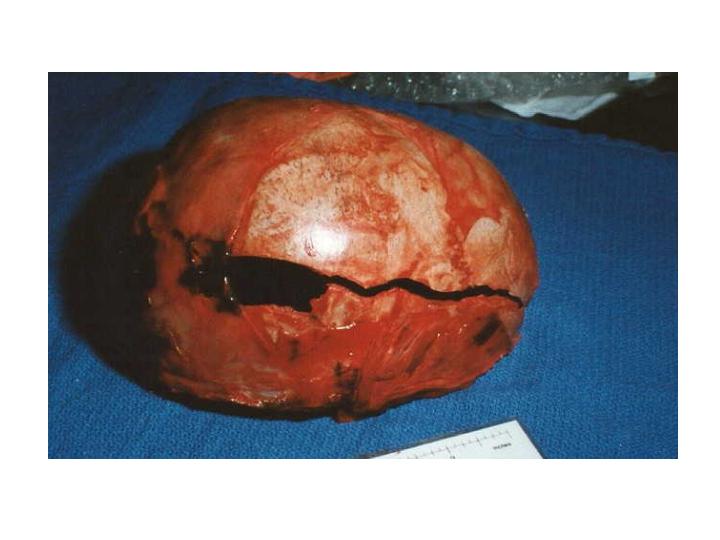
Head wounds normally bleed very profusely. If someone is hit on the head with any force at all it will either swell or it will bruise or it will bleed. In the case of JonBenét, even the coroner did not see a head wound. There was no swelling, there was no bleeding that was visible, there was no bruising.

If JonBenét was hit on the head first there would be some length
of time between the time you would even think of staging this crime - then
you would have to go out and you would have to find duct tape, you would
have to find cord and you would have to construct a garrotte and you would
have to tie her hands, and you would have to bring her down into the basement.
That would have taken all that time to do this, there would have been massive
bleeding. So, it's ludicrous even to think the head blow came first.
That did not happen. The head blow came last, almost at the
time of death
NARRATOR - As Prosecutor Michael Kane took over the case and prepared
to argue differently, the DA staff members who believed the parents
were innocent were moved to other duties. Only Smit remained until he too
was locked out of the homicide office and prevented from pursuing a number
of other suspects - any one of which, he says, could be the killer.
As the focus moved back to the Ramseys, Smit was appalled that vital
evidence left at the crime scene, including mystery DNA, was being
ignored.
LOU SMIT - This crime can be solved. Our killer in this case left a lot of evidence behind. JonBenét, under fingernails, had foreign DNA. In her panties there is foreign DNA. It does not belong to anybody in this family. I think JonBenét got a piece of her killer. There is also a hair left at this scene. It was right on the blanket that was covering JonBenét.

This is a Caucasian hair and it's not John and it's not Patsy Ramsey's
hair. Is it our killer's hair? Whoever left it there
better have a very good reason for leaving it there. There
are so many clues left behind on this scene. Many murders are solved
with less clues than this. But in order to find the killer we have to look
for him.
.
NARRATOR - Stopped from pursuing other suspects and expected to support
the indictment of the Ramseys, Lou Smit finally resigned, 18 months
after taking on the case.
LOU - I resigned because I thought there was something drastically wrong and that there was a gross injustice in this case. I had seen evidence of an intruder in the house that night, and I wasn't alone, there was other people that had seen that too, and that, all of us that wanted to pursue the intruder part of this equation were being removed from the case.
NARRATOR - But asLou Smit was to find out, the worst was yet to come.
End part 5
Part 6
NARRATOR - Even after his resignation from the Ramsey murder case, DA investigator Lou Smit continued to hunt on his own for the intruder he was now sure had killed JonBenét. To help her parents, he also sought permission to give his evidence to the Grand Jury. He was stunned by the response.
In February, 1999, Michael Kane, now running the Grand Jury, wrote to Smit. He told him that his request to give evidence to the Grand Jury 'is denied'. At the same time, Kane issued an injunction against Smit. It demanded the surrender of all his evidence and sought court permission to 'permanently erase' it.
A shocked Smit once more turned to former DA Bob Russel for advice.
BOB RUSSEL - Once I saw that they had, in fact, gone to court and got an injunction, it really made me mad. The evidence was too strong that the Ramsey's didn't do this. And so to see that anybody is trying to really get the Ramseys indicted when I had already seen the evidence that showed they probably didn't do it, really bothered me.
NARRATOR - To help him protect Smit, Russel turned to Greg Walta, a man he often faced in court.
GREG WALTA - I was stunned. I frankly had never seen anything like it. The prosecutor's job is to make sure that a Grand Jury hears all the evidence - not just some of the evidence. And a prosecutor's job is to protect evidence - not destroy it. So I was stunned and I was determined to fight it.
NARRATOR - The two men who had so often faced each other across a court room now forged an alliance to ensure Smit's evidence was heard. They won a striking victory. They obtained a court injunction allowing Smit not only to keep his evidence, and also to use it in any way he saw fit. Smit was also allowed to testify to the Grand Jury.
GRAND JURY VERDICT ANNOUNCEMENT - DA ALEX HUNTER -" ...we do not have sufficient evidence to warrant the filing of charges against anyone who has been investigated at this time
NARRATOR - When Alex Hunter announced the Grand Jury's verdict - that the Ramseys should not be indicted - few doubted this was because of what Smit had done. Yet today,despite Smit and despite the grand jury, most Americans still believe the Ramseys killed their daughter.
PATSY PLAYING PIANO

NARRATOR - Just before her death, JonBenét mastered this tune on the piano. For her parents the agony of her death continues. They remain outcasts. They are broke and broken, and its likely to stay that way.
GREG WALTA - I think the case is in deep trouble and I think it's in deep trouble because the Boulder Police Department has really staked it's reputation on the Ramseys being guilty. And once that's happened, that police department can't perform it's function. And so I think the Bolder Police Department is virtually incapable of solving this case at the present time.
LOU SMIT- What a double travesty this could be - the killer running
free and innocent people being charged with a crime they did not commit.
End Part 6
Producers - David Mills and Michael Chrisman
Executive Producer for Mills Productions - Michael Tracey
Narrator - Les Marshak
Director of Photography - Patrick Turley
Camera - Ben Turley
Sound - Tim Watts
~~~~~~~~~~~~~~~~~~~~~~~
Statement issued by DA Mary Keenan:
DISTRICT ATTORNEY'S
OFFICE
TWENTIETH JUDICIAL
DISTRICT
MARY I KEENAN. DISTRICT
ATTORNEY
April 7, 2003
I have carefully reviewed
the Order of United States District Court Judge Julie Carnes in the
civil case of Wolf
v. John Ramsey and Patricia Ramsey. I agree with the Court's conclusion
that
"the weight of the
evidence is more consistent with a theory that an intruder murdered
JonBenet than it is
with a theory that Mrs. Ramsey did so."
Although issued in
the context of a civil case, the Court's ruling is a thoughtful and well
reasoned decision
based on the evidence that was presented by the parties in that case. It
should be read in
its entirety.
John and Patricia Ramsey
have been the focus of an exhaustive investigation with regard to
the murder of their
daughter, JonBenet, for more than six years. People charged with a crime
are presumed to be
innocent until proven guilty in court. Since Mr. and Mrs. Ramsey have not
even been charged,
much less convicted, they must be presumed innocent and must be
treated accordingly.
For several months,
my office has been investigating new and other unpursued leads, most of
which involve the
possibility that an intruder committed this crime. We are proceeding with
the full cooperation
of the Ramseys, Detective Lou Smit, and the Boulder Police Department.
We are all focused
on the apprehension and successful prosecution of the killer of JonBenet.
If anyone wants to contact me, please email me
or send snail mail to
jameson
PO Box 5333
Hickory, NC 28603